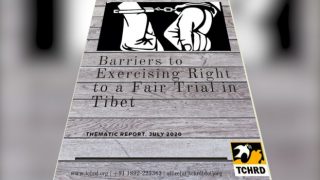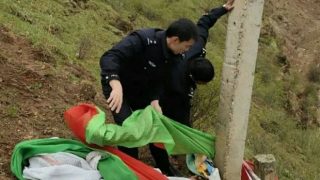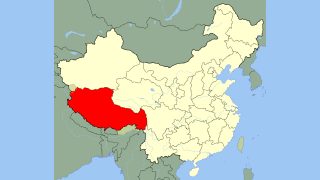
May 17 marks 25 years since Chinese security forces took away a 6-year-old Tibetan child, Gendun Choeki Nyima, and his parents from a remote town in Tibet. They have not been heard from since. Today, no one apart from the Chinese authorities has any idea where they are, what they do, or whether they will ever be seen in public or live freely again.
And yet neither the child, now in his early 30s if he’s still alive, nor his family members had been accused of any crime. Rather, the boy had been identified by a team of Tibetan monks and lamas as the reincarnation of a premier religious teacher, the Panchen Lama, a decision that the Chinese government opposed.
The authorities, using a procedure that lacked authenticity and involved fabrication, forced another group of monks to identify a different child of the same age, Gyaltsen Norbu, as the official reincarnation of the Panchen Lama.
Ever since, that second candidate has been paraded annually in Tibet, accompanied by police, officials and a massive publicity operation involving hundreds of coerced worshippers. In between these visits, he has effectively been held under house arrest in Beijing and never been allowed to travel freely or to speak openly with foreigners.
Chinese authorities’ efforts to justify a quarter-century enforced disappearance of a child are ludicrous and chilling: They say Gendun Choeki Nyima is being kept somewhere secret “for his own protection.” Gyaltsen Norbu’s lack of freedom appears never to have been questioned by the Chinese authorities, apparently because they imagine effective incarceration in Beijing to be appropriate.
However, in the Tibetan tradition, genuine reincarnate lamas are expected to travel widely, study in a range of institutions, and meet with a broad range of lamas to obtain the teachings and transmissions that are central to their claims to knowledge and religious authenticity. Once they reach adulthood, they are also free to walk away from their religious commitments, as happens relatively frequently outside Tibet.
The 17th Karmapa, another high-ranking lama recognized by Chinese authorities in the 1990s, was at least permitted to receive an education at his own monastery — an experiment that ended in ignominy for authorities when he fled into exile in 1999. But no such chances have been taken with the official Panchen Lama, who remains a captive in a propaganda showcase, ironically one intended to display the government’s granting of religious freedom to Tibetans.
The underlying issues behind this travesty of human rights violations are, of course, political. Chinese authorities want absolute control of the selection of the next Dalai Lama, since the current 14th of that lineage is the unquestioned leader of the Tibetan people; he is now 85 years old and living in exile in northern India. The two individuals chosen as the Panchen Lama have had their lives ruined by the Chinese government simply so that it can declare one to be a Tibetan lama of sufficient seniority to install its chosen child as the 15th Dalai Lama once the current Dalai Lama dies, instead of the child likely to be selected by Tibetans in exile.
The Dalai and Panchen Lamas were the supreme figures of spiritual authority in Tibet’s former religious government and enjoy a reverence among Tibetans that transcends the plurality of regional and sectarian affiliations. They were linked by, among other things, a unique authority in the selection and tutelage of each other’s successive reincarnations. The breakdown of this special relationship in the early 20th century was used by China’s Nationalist government, and to much greater effect by the Communist Party, to intervene in and take control of Tibet’s political affairs. Following the direct imposition of Communist rule in the 1950s, the Dalai Lama fled into exile in India, along with some 80,000 refugees. At least another 40,000 Tibetans settled in exile in the early 1980s.
Governments do sometimes play a role in the appointment of leading clerics in their country – the British monarch, for example, appoints bishops of the state church. But in such cases the role of governments is to confirm the choices made by religious communities, and to defend the wishes of its adherents.
The Chinese government’s religious role in Tibet, as elsewhere in the country, is exactly the opposite: It is actively trying to limit religion in Tibet, prohibiting students from all religious belief, banning religious activities for government employees even when retired, and requiring religious doctrines to be reinvented as part of “Sinicization.” In the predominantly Muslim region of Xinjiang it is detaining thousands of Turkic Muslims for ordinary acts of faith.
If the Chinese government wishes to show that it respects even marginally the interests of Buddhists in Tibet, who universally regard the Dalai Lama as their religious leader and representative, it would cease publicly insulting him. Chinese authorities would engage in dialogue with him, allow free discussions between him and clerics inside Tibet, confirm his appointments, stop ordering the Sinicization of Buddhist teachings, and withdraw the teams of officials it has placed in each monastery in Tibet.
So far, the government’s efforts to force its nominee on the Tibetan public have failed: Although many Tibetans are sympathetic to the ordeal experienced by the official Panchen Lama, anecdotal evidence suggests that almost no one displays pictures of him except when forced to do so. For ordinary believers, the government has ruined it credibility as an arbiter of religious affairs by its abuse not just of the two candidates, but of the revered title itself.
The Chinese government needs to show genuine respect for the Tibetan religion, its believers and its current leaders, starting with the current Dalai Lama. Without that, the evidence so far is that Chinese authorities’ enforced parading of innocent abductees as its proxies in Tibet will not gain support from the Tibetan public or others concerned about religious freedom. The two Panchen Lamas and their families, whose fundamental rights have been abused for 25 years, should be allowed their freedom immediately.
Source: Human Rights Watch. 25 Years After ‘Disappearing’ Tibetan Panchen Lama, China Is No Nearer to Its Goal. © 2020 by Human Rights Watch.



